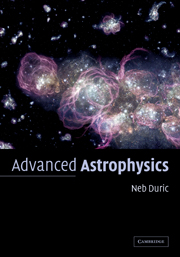Part I - Classical mechanics
Published online by Cambridge University Press: 05 June 2012
Summary
The visible Universe contains hundreds of billions of galaxies, each consisting of billions of stars. Recent discoveries of extrasolar planets lead us to believe that a typical galaxy may contain billions of planets (and presumably, asteroids and comets). The planets, stars and galaxies interact on a hierarchy of scales ranging from AU to parsec to megaparsec, experiencing forces arising from gravity, on all scales, and cosmic expansion on the larger scales. The combination of gravitational attraction and cosmic expansion has shaped the visible matter in the Universe into a hierarchy of structures leading to clusters and superclusters of galaxies.
A full description of the interactions that define the large-scale structure of the Universe and its constituent parts requires the application of general relativity on all scales and the introduction of a new force, as embodied in the recently proposed cosmological constant, on the largest scales. In this part, however, we limit ourselves largely to the application of classical (Newtonian) mechanics which is sufficiently accurate to describe the topics covered in this part and has the advantage of being more intuitive and accessible to the reader.
This part begins with a review of the basic elements of classical mechanics, subsequently used to derive Kepler's laws, the Virial theorem and various aspects of orbital motion. The resulting derivations are applied to specific astrophysical problems such as planetary motion, extrasolar planets, binary stars, galaxy rotation curves, dark matter, the large scale structure of the Universe and cosmic expansion.
- Type
- Chapter
- Information
- Advanced Astrophysics , pp. 1 - 2Publisher: Cambridge University PressPrint publication year: 2003



